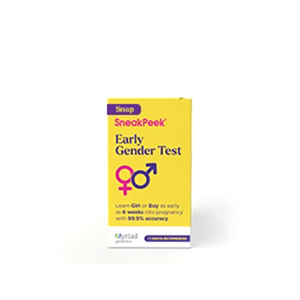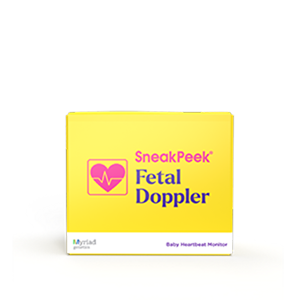Published on September 10th, 2022 and Updated on January 20th, 2024
Check out SneakPeek Gender Test to find out your baby’s gender as early as 6 weeks at over 99% accuracy!
Table of Contents
The Role of Areolas in Breastfeeding and Pregnancy Changes?
What causes areolas to change?
Other breast changes during pregnancy?
How to manage breast discomfort?
Do breast changes from pregnancy last forever?
Understanding Areola Changes During Pregnancy
Areolas, the dark-colored halos surrounding your nipples, can change many times in your life, and some of the biggest transformations occur when you’re pregnant—possibly starting as early as four weeks. It’s definitely one of the pregnancy symptoms to watch out for.
During pregnancy, the areola becomes darker in color and may also increase in size. These changes serve an important purpose: they are believed to help newborns locate the nipple and establish a strong latch for nursing.
In this guide, we’ll dive into every change you might notice and explore what else your breasts may experience along your pregnancy journey.
What do areolas look like normally?
Areolas are sensitive, intimate parts of the body. They come in an endless array of unique sizes, shapes, and colors.
That said, most women’s areolas fall in a spectrum of “typical” and healthy. Let’s take a look at what most areolas might look like when your body isn’t gearing up for a baby so that we can compare them to what they may look like when your body is.
Typical Areola Size
The average areola measures between 1.2 to 2.4 inches in diameter. However, many healthy areolas can be smaller or larger—it all depends on your genetic makeup.
Areola size changes are normal (and common) throughout a woman’s life. In addition to pregnancy, women usually experience areola size changes during the following periods of hormonal transformation:
- Puberty
- Menstruation
- Breastfeeding
In some cases, areolas enlarged for endocrinal reasons will return to their normal size once the hormonal changes have died down (this is common after breastfeeding). In others, changes to the areolas are permanent (for example, following puberty).
Because the areola size spans a wide range, the most important thing to look for in yours is consistency. If your size remains mostly static, the areola diameter is likely perfectly healthy.
Typical Areola Texture
Ever noticed those tiny little bumps on your areolas? They’re not goosebumps—those are known as your Montgomery glands.
The Montgomery glands are a monument to your areolas’ primary functional purpose: nourishing your future baby. These raised pores are designed to help you and your baby during breastfeeding by:
- Creating a textured surface for the baby’s mouth to latch onto
- Secreting natural, antiseptic oils, which moisturize and protect the area around your nipples
- Releasing a subtle scent that researchers believe may help your baby locate and zero in on your nipple when feeding
The texture of Montgomery glands varies by individual. Your non-pregnant areolas may feel bumpy or smooth, and your glands may be consistent or speckled around your nipples.
These variations are normal. Bear in mind that if your Montgomery glands are bumpy, it’s best not to pick at them. This can lead to skin damage, infections, or gland dysfunction.
Typical Areola Color
Red, pink, beige, and brown—areolas come in a rainbow of colors. They are usually darker or lighter in pigmentation than the nipples. Most women naturally have differing shades between their areolas and their nipples.
During pregnancy, gradual areola color changes are quite common, but you might also experience gradual color changes outside of pregnancy in the following circumstances:
- During menstruation
- During menopause
- After childbirth (if breastfeeding)
- After breast surgery
It’s sudden major color changes that are not normal and should be further inspected. If you notice a sudden or severe change in your areolas’ color (or texture), contact your healthcare provider. This could be a sign of Paget’s Disease (a form of breast cancer that affects the nipples), or another breast-related medical condition.
The Role of Areolas in Breastfeeding and Pregnancy Changes?
Noticing changes in your areolas can be one of the early indicators of pregnancy. If you’re trying for a baby and observe your areolas broaden, your Montgomery glands become more prominent, or your nipples and areolas change color, it may be a sign to take a pregnancy test.
During pregnancy, the areolas undergo significant transformations, as they play a pivotal role in preparing for breastfeeding – one of the most important tasks in early child-rearing. Most women will observe three primary changes in their areolas:
During pregnancy, most women will notice three major changes in their areolas:
Increased Areola Size
Enlarged areolas is one of the common signs in early pregnancy. This size increase, typically happening within the first few weeks of the first trimester, helps create a more visible target for the baby, facilitating effective latching during breastfeeding.
Enhanced Montgomery Glands
During pregnancy, Montgomery glands usually enlarge and protrude further. These glands are crucial for breastfeeding as they secrete oils and a unique scent that not only moisturize and protect the nipple but also aid the baby in locating the nipple for feeding.
Areola Darkening
Late in the first trimester, you might notice you have dark nipples. Areola darkening will likely continue throughout your entire pregnancy, but both areolas won’t necessarily darken at the same rate. You may notice they color shift one at a time or that they ultimately reach different shades—all of this is completely normal!
These changes in the areolas are all part of your body’s natural preparation for feeding and nurturing your newborn. They highlight the remarkable ways in which a woman’s body adapts to support the growth and development of her baby.
What causes your areolas to change during pregnancy?
When you’re pregnant, virtually every areola change—whether in color, texture, or size—is designed to tell your baby where to latch on. What are the causes of your areolas’ shapeshifting? Like most changes during pregnancy, it all comes down to hormones.
After conception, your body disburses a hormonal cascade to help nurture your little bun’s growth – in the womb and also after birth. Four main hormones lead the charge when it comes to preparing your body for breastfeeding:
- Estrogen, which modulates the size of your milk ducts and releases pigmentation
- Progesterone, which grows the glandular buds (your nipples) and releases pigmentation
- Prolactin, which enlarges the breasts and encourages milk production
- Human placental lactogen (HPL), which contributes to ductal growth in the mammary gland
Other Breast Changes During Pregnancy
During pregnancy, your body undergoes a myriad of changes, and your breasts are no exception. These changes are not just limited to the areolas but encompass the entire breast, preparing your body for the crucial role of nurturing your newborn.
Breast Tenderness, Achiness, and Sensitivity
These are often the first physical signs women notice, sometimes as early as four weeks into pregnancy. Hormonal fluctuations, particularly in estrogen and progesterone, lead to these sensations, making your breasts feel sore and sensitive.
Darker veins
Your boobs are a busy zone during pregnancy. As your body prepares to breastfeed, it conducts more blood to your breasts, so you may see larger, darker, and more noticeable veins around your chest. These are usually visible by the end of the first trimester (around 12 weeks).
Sizing up
Can’t fit your bra? By the second month of pregnancy, you’ll probably notice considerable swelling in your breasts. As developing milk ducts continue to grow over the next nine months, moms-to-be can expect a boost of between one or several cup sizes.
Colostrum
At the beginning of the second trimester, some women notice their nipples secrete small amounts of a viscous yellow fluid called colostrum. Think of this nutrient-dense, antioxidant-filled liquid as your body’s test run for providing your baby with breast milk. Your breasts will continue to produce colostrum until around 2 to 4 days after you deliver your little one, where it will then switch to breastmilk.
Nipple Discharge
Nipple discharge, primarily in the form of colostrum, is common and normal. However, any unusual color or odor should be checked by a healthcare professional.
Lumps and Growth
It’s common to feel lumps or growths in the breasts during pregnancy due to glandular development and changes. While these are usually benign, it’s important to have any new lumps checked by a doctor.
Stretch Marks
As breasts enlarge, the skin stretches, possibly leading to stretch marks during pregnancy. These are normal and vary from person to person.
How to manage breast discomfort
Pregnancy brings about significant changes in your body, and managing breast discomfort is a common challenge for many expectant mothers. Here are some practical tips to help alleviate discomfort and maintain breast health during this important time:
Use of Breast Pads
Breast pads, also known as nursing pads, can be a lifesaver, especially if you experience nipple discharge or colostrum leakage. They come in both disposable and reusable varieties and can be placed inside your bra to absorb any moisture, keeping you comfortable and dry.
Applying Lotions for Skin Relief
The skin around your breasts and nipples can become particularly sensitive and stretched during pregnancy. Using hypoallergenic lotions or creams specifically designed for pregnant women can help soothe and moisturize the skin, reducing itchiness and discomfort.
Treating Blocked Milk Ducts
Blocked milk ducts can occur during pregnancy, leading to discomfort and sometimes infection. Warm compresses and gentle massage can help unblock the ducts. If you experience persistent blockage, redness, or pain, it’s important to consult with a healthcare provider.
Do breast changes from pregnancy last forever?
Breast changes during pregnancy have pros and cons for all women. Some may love the extra curves, while others may prefer their body the way it was. If you’re wondering whether these modifications to your areolas and breasts will continue beyond your pregnancy, the answer is maybe. It depends on three main factors:
Genetics
After your due date, hormones will eventually return to their pre-pregnancy baseline. For some women, this leveling restores how their breasts originally appeared. For others, their areolas, nipples, and breasts may remain changed by pregnancy.
Pregnancy weight gain
When you put on weight during pregnancy, your body introduces more fat breast tissue. This additional fat may add bulk to your breasts—and this bulk may stick around after you give birth or stop breastfeeding your baby. In some women, mammary growth during pregnancy can also stretch out the breasts, diminishing their elasticity and altering their shape.
Breastfeeding
If you breastfeed, the hormones responsible for producing breast milk will likely keep your areolas and breasts the same shape, size, and color they were while you were pregnant. When you stop breastfeeding, your original areola color and breast size may or may not return. It all depends on your individual genetics and weight gain during pregnancy.
Celebrate The First Sign with SneakPeek
Understanding the first few pregnancy symptoms, including areola changes, can help you feel more connected with your body. Once your pregnancy is confirmed, you can connect with your little bundle of joy with the SneakPeek At-Home Early Gender Prediction Test. This DNA-based, at-home gender blood test can predict the sex of your baby just 6 weeks into your pregnancy—that’s two weeks after your areolas give the baby signal and months before your 20-week gender reveal ultrasound.
Trusted by over 1 million moms, SneakPeek is the #1 OBGYN-recommended at-home gender test on the market, offering over 99% clinically proven results, privacy protection, and a 100% money-back guarantee.
Learn more about your little one sooner than ever before by choosing SneakPeek.
Editorial Policy
At SneakPeek, our commitment is to provide accurate, up-to-date, and reliable information to empower our readers. Our content is thoroughly researched, reviewed by medical experts, and fact-checked to ensure its credibility. We prioritize the well-being and education of our readers, and our editorial policy adheres to the highest standards of integrity and accuracy in all our articles.
This post has been reviewed for accuracy by the following medical professional:
Katie Smith is a seasoned Certified Nurse Midwife and a nurturing mother to six children, offering a unique blend of professional expertise and personal experience. She is the founder of Birth Your Way Midwifery and Women’s Wellness Center in Bay County, Florida. Katie's comprehensive approach to care is informed by her hands-on experience in motherhood and her passion for empowering women through their birthing journey. Her dedication extends beyond her center as she actively engages in community wellness and family health education.
Sources:
- Baby Centre. Breast tenderness, sore nipples, and other breast changes during pregnancy. https://www.babycenter.com/pregnancy/your-body/breast-tenderness-sore-nipples-during-pregnancy_262
- Cleveland Clinic. Breast Anatomy. https://my.clevelandclinic.org/health/articles/8330-breast-anatomy
- Cleveland Clinic. Colostrum. https://my.clevelandclinic.org/health/body/22434-colostrum
- Diagnostic and Interventional Imaging, Volume 96, Issue 10. https://doi.org/10.1016/j.diii.2015.07.005.
- Gland Surgery. Anatomy of the nipple and breast ducts – Zucca-Matthes. https://doi.org/10.3978/j.issn.2227-684X.2015.05.10
- Healthline. Breast Changes in Pregnancy: What to Expect. https://www.healthline.com/health/pregnancy/pregnant-breast
- Hopkins Medicine. Hormones During Pregnancy. https://www.hopkinsmedicine.org/health/conditions-and-diseases/staying-healthy-during-pregnancy/hormones-during-pregnancy
- Mayo Clinic. Stretch marks. https://www.mayoclinic.org/diseases-conditions/stretch-marks/symptoms-causes/syc-20351139
- NHS. Paget’s disease of the nipple. https://www.nhs.uk/conditions/pagets-disease-nipple/
- NIH. Cross-sectional observational study of nipple and areola changes during pubertal development and after menarche in 313 Italian girls. https://pubmed.ncbi.nlm.nih.gov/27649000/
- NIH. Hyperkeratosis Of The Nipple And Areola. https://www.ncbi.nlm.nih.gov/books/NBK459144/
- NIH. How Milk Gets from the Breast to the Baby. https://www.ncbi.nlm.nih.gov/books/NBK153490/
- NIH. Breast pads: their effectiveness and use by lactating women https://pubmed.ncbi.nlm.nih.gov/8489718/
- NIH. Anatomy of the nipple and breast ducts. https://www.ncbi.nlm.nih.gov/pmc/articles/PMC4716863/
- NIH. Guidelines for the Treatment of Inflammatory Breast Disease during the Lactation Period. https://www.ncbi.nlm.nih.gov/pmc/articles/PMC3964351/
- Verywell Family. Changes to the Areola During Pregnancy and Breastfeeding. https://www.verywellfamily.com/breastfeeding-the-areola-431668

Shop Our Products
SneakPeek aims to provide the most accurate and up-to-date information to help our readers make informed decisions regarding their health before, during, and after pregnancy. This article was written based upon trusted scientific research studies and/or articles. Credible information sources for this article are cited and hyperlinked.






